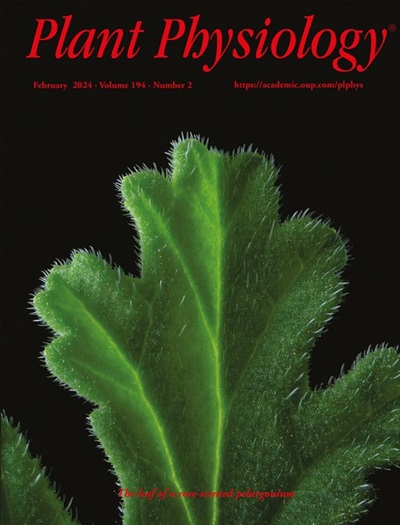玉米中苯并恶嗪途径与硼平衡的关系
IF 6.5
1区 生物学
Q1 PLANT SCIENCES
引用次数: 0
摘要
微量元素硼的缺乏和毒性都会导致作物严重减产。尽管硼对农业具有重要意义,但植物体内硼平衡的分子基础仍不清楚。为了确定参与玉米(Zea mays L.)硼平衡的分子角色,我们测量了 Goodman-Buckler 关联面板中的硼水平,并进行了全基因组关联研究。这些分析确定了一个无苯并恶嗪(bx)基因 bx3,它参与了苯并恶嗪类化合物(如 DIMBOA)的生物合成,而 DIMBOA 是玉米的主要防御化合物。参与 DIMBOA 生物合成的基因在基因组中的位置都很接近,包括 bx3 在内的苯并恶嗪类生物合成突变体都缺乏 DIMBOA。我们发现 bx3 突变体的叶片比 B73 对照植株的叶片硼浓度更高,这与叶尖坏死的加剧相对应,叶尖坏死是一种与硼毒性相关的表型。相比之下,其他 DIMBOA 缺失的玉米突变体并没有表现出硼含量的改变或叶尖坏死表型,这表明硼与 DIMBOA 无关。相反,我们的分析表明,硼的积累与苯并噁嗪中间体吲哚啉-2-酮(ION)和 3-hydroxy-ION 有关。因此,我们的研究结果通过 bx3 和特定的中间体将硼平衡与苯并恶嗪类植物防御途径联系起来,使苯并恶嗪类生物合成途径成为硼不足条件下作物改良的潜在目标。本文章由计算机程序翻译,如有差异,请以英文原文为准。
Association of the benzoxazinoid pathway with boron homeostasis in maize
Both deficiency and toxicity of the micronutrient boron lead to severe reductions in crop yield. Despite this agricultural importance, the molecular basis underlying boron homeostasis in plants remains unclear. To identify molecular players involved in boron homeostasis in maize (Zea mays L.), we measured boron levels in the Goodman-Buckler association panel and performed genome-wide association studies. These analyses identified a benzoxazinless (bx) gene, bx3, involved in the biosynthesis of benzoxazinoids, such as DIMBOA, which are major defense compounds in maize. Genes involved in DIMBOA biosynthesis are all located in close proximity in the genome, and benzoxazinoid biosynthesis mutants, including bx3, are all DIMBOA deficient. We determined that leaves of the bx3 mutant have a greater boron concentration than those of B73 control plants, which corresponded with enhanced leaf tip necrosis, a phenotype associated with boron toxicity. By contrast, other DIMBOA-deficient maize mutants did not show altered boron levels or the leaf tip necrosis phenotype, suggesting that boron is not associated with DIMBOA. Instead, our analyses suggest that the accumulation of boron is linked to the benzoxazinoid intermediates indolin-2-one (ION) and 3-hydroxy-ION. Therefore, our results connect boron homeostasis to the benzoxazinoid plant defense pathway through bx3 and specific intermediates, rendering the benzoxazinoid biosynthesis pathway a potential target for crop improvement under inadequate boron conditions.
求助全文
通过发布文献求助,成功后即可免费获取论文全文。
去求助
来源期刊

Plant Physiology
生物-植物科学
CiteScore
12.20
自引率
5.40%
发文量
535
审稿时长
2.3 months
期刊介绍:
Plant Physiology® is a distinguished and highly respected journal with a rich history dating back to its establishment in 1926. It stands as a leading international publication in the field of plant biology, covering a comprehensive range of topics from the molecular and structural aspects of plant life to systems biology and ecophysiology. Recognized as the most highly cited journal in plant sciences, Plant Physiology® is a testament to its commitment to excellence and the dissemination of groundbreaking research.
As the official publication of the American Society of Plant Biologists, Plant Physiology® upholds rigorous peer-review standards, ensuring that the scientific community receives the highest quality research. The journal releases 12 issues annually, providing a steady stream of new findings and insights to its readership.
 求助内容:
求助内容: 应助结果提醒方式:
应助结果提醒方式:


